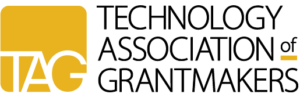(Chicago, IL) – Further advancing an earlier study which confirmed that 39% of our grant applications are duplicative across funders, the Technology Association of Grantmakers (TAG) has published the list of shared fields that comprise the nearly 40% of grant application overlap.
“We are pleased to share data that will help reduce redundancy and enable a more humane charitable sector,” says TAG Executive Director, Chantal Forster. “Many of the shared form fields are candidates for auto-population from shared data repositories or for removal altogether. This data is a call to modernize and leverage technology to create space and time for a more humane philanthropy that focuses on trust and relationships.”
The data science effort led by TAG relied upon over 130 grant applications shared by foundations throughout North America, the EU and UK. The first phase of the work to identify the level of similarity between forms was published in August 2021 and indicates that nearly 40% of fields in the sample were duplicative across funders.
This second phase reduced the roughly 3,600 form fields to 13 question groups through a multi-method and multi-analyst data triangulation approach led by data scientist Kwame Porter Robinson. The process also sanitized the data to remove foundation identifiers and prepare for publication.
13 Groups of Common Questions
Below are the thirteen groups of questions generated by this research from an original dataset of roughly 3,600 question fields. Shown in parentheses is the percent (%) that this group represents from the full set of 3,577 grant form fields:
- Organizational Biographical and General Information (18%)
- Miscellaneous (3%)
- Corporate Delegation and Oversight, Organizational Structure (5%)
- Data Handling, Overview, Measurement, Evaluation and Reporting (4%)
- Project Demographics/Orientation/Status (2%)
- Alternative Supports ( <1%)
- How Did You Hear of Us ( <1%)
- How has COVID-19 Impacted Your Work ( <1%)
- Organizational Budgeting, Revenue Practices, and Forecasts (20%)
- Collaborative Partnerships and Community Support (5%)
- Requested Grant Funding Related (20%)
- Time Spent Filling Out the Form ( <1%)
- What the Organization Does (22%)
View the full list of questions within each group (PDF).
NOTE: This data is provided as an interim step in the process of moving toward standard questions, auto-populating form fields, and reducing the number of questions asked on grant applications, an effort we hope the philanthropic sector will consider pursuing. It is important to note that TAG is NOT suggesting grantmakers use all the questions identified by this study in their grant applications.
What’s Next for the Sector?
Find out how this data might be used to further streamline and consolidate grant applications. Join a working session on January 26, 2022 to explore the implications of these findings and the possibility for sector-led efforts to respond.
Research Conducted By
Data analysis was conducted by data scientist Kwame Porter Robinson, a PhD student specializing in human interaction with artificial intelligence (HAII) and natural language understanding (NLU) at the University of Michigan’s School of Information. In his four-part analysis, Robinson leveraged a combination of human-guided machine learning, clustering techniques, and corpus-based similarity analysis drawn from long standing semantic similarity and information retrieval research.
An in-depth report on methodology, and findings can be found in the full report by Kwame Porter Robinson.
You can find Robinson’s scripts used in this analysis on Github.
Research Funded By
Funding for this research was provided by The John D. and Catherine T. MacArthur Foundation and an award from the Robert Wood Johnson Foundation.
